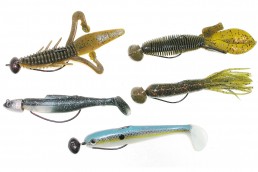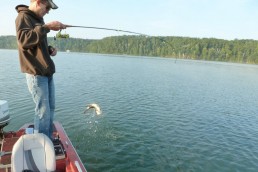Articulated Jigs for Jammin’ on July Bass
SHARE THIS POST
Definition for “articulated” from dictionary.com:
- made clear or distinct: articulated sounds.
- having a joint or joints; jointed: an articulated appendage.
- (of a vehicle) built in sections that are hinged or otherwise connected so as to allow flexibility of movement: an articulated bus; an articulated locomotive.
Let me articulate something right here: Soft plastic creature baits and swimbaits paired with articulated heads—a joint between them and the hook—can be awesome. This design lets the soft plastic lures behind the heads swing freely. They are also one of the easiest lures to use for folks not experienced at bass fishing. For the most part, you can cast them, wind them and catch fish with them. The extra swiveling action does the trick, and at times, this simple setup will catch numbers of fish when other presentations don’t.

When you see something like a Strike King Rodent behind one of these articulated heads you can see just how much more like a crawfish or an injured baitfish the lure appears. You drag it along the bottom or swim it just above and the soft plastic has a sort of “quiver” that must trigger the predatory instinct of a bass. When one of these lures with a creature-type soft plastic falls to the bottom, it initially has the look of a crawfish, with its claws upraised, ready to defend itself. As soon as you start the retrieve, water resistance forces the plastic down to trail behind the head, right along the bottom just like a crawfish on the move.
Pair an articulated head with a swimbait and you get an extra shimmy that looks like a prey fish in trouble. The joint between the head and the plastic adds way more action to the presentation, making the whole body move. Note: Sometimes less is more, and a more standard swimbait on a keel hook or on a standard jig head works better, depending on the mood of the fish. Sometimes the reduced action garners more strikes. In May, I started experimenting with a regular tube on an articulated jig head for bedding fish—bass ate it up.
But let’s talk about July. One of the best summertime tactics for largemouths in Midwestern lakes is attacking the deep side of weed beds, where bass hang out hunting bluegills at depths of 12 to 20 feet, sometimes a deeper, sometimes shallower. A football-shaped articulated head is ideal now, as its shape keeps the jig from rolling over on its side. You want a fairly big one to sink quickly into the strike zone, provoking a bass to snap at it. This is where a slack-line, jerk retrieve can really shine. You can set up to cast parallel to the weed edge or sit in deeper water and cast into the edge of the weeds, letting the jig fall all the way to the bottom. The weight of the jig head can be as little as 1/2 ounce to 1 ounce. After you cast and the jig settles, allow a little slack to get in your line and pull the rod tip back so that when you make contact with the jig it scoots forward a bit. Repeat and let the jig fall. Put a little slack in your line and pull sharply again, moving the jig 1 to 3 feet. This scoot-fall-pause-scoot motion is often more effective at triggering strikes than a simple lift-fall retrieve like you’d do with a Texas-rigged worm. That’s not to say a simple lift-fall retrieve won’t work—sometimes the bass want it that way and you’d best cater to their desires.
For this outside-the-weedline technique, I like a 7-foot 2-inch, medium-heavy casting rod that is lightweight and sensitive. I pair this with a Shimano Curado 70, with the 7:1 retrieve ratio. This speedy reel is great with this technique, as sometimes a bass will pick up the bait and swim at you. The faster ratio let’s you catch up easily to set the hook.
Are you enjoying this post?
You can be among the first to get the latest info on where to go, what to use and how to use it!
Some anglers like to use braided line for this with a fluorocarbon leader, but I prefer to spool up with fluorocarbon, as many of the lakes I fish in July are clear. I don’t care what anybody says—I think bass are line-sensitive. Plus, using a short leader of fluoro with braided line adds another knot and a possible point of breakage. I’ve had success with 14-pound-test Seaguar AbrazX, which is highly resistant to abrasion. Also, extra-wide gap hooks work well with these soft plastics, allowing you to skin-hook the point in the plastic body and make the presentation weedless.
For swimbaits, it’s tough to beat a jig head that looks like a baitfish head, such as the Hydra Head from Freedom Tackle. These have a shiny finish and eyes and do a good job of mimicking a real baitfish. They match up well with 5-inch soft swimbait bodies and deliver a weedless lure that works in weeds as well as open-water situations. Freedom Tackle also makes the Stealth Head, which has the eyelet on the point of the nose and does an even better job of snaking through weeds with its tail wagging. Biting off the tip of the soft plastic’s head allows the back of the Hydra and Stealth heads to join smoothly with the plastic.
Swimbaits can also be paired with articulated football heads, such as the Biffle Hard Head from Gene Larew or the Freedom Football Head for fishing right along the bottom. The lure imitates a baitfish feeding on the bottom. Of course you can swim the swimbait right along the surface with an articulated football head too.
One last point worth making about articulated heads is they are somewhat more difficult for a fish to throw, as these lure heads don’t provide leverage to help a fish shake it out of its mouth.
Simple-to-use fish-catchers, the articulated heads are definitely worth adding to your repertoire. Add some to your arsenal this summer, try some different retrieves and hang on.
Tournament angler and avid outdoorsman Buck Mallory, of Lawton, Mich., is a regular contributor to MidWest Outdoors, specializing in bass fishing.
MWO
SHARE THIS POST
Did you enjoy this post?
You can be among the first to get the latest info on where to go, what to use and how to use it!
Buck Mallory
Tournament angler and avid outdoorsman Buck Mallory of Lawton writes Michigan-specific bass fishing articles for MidWest Outdoors.



